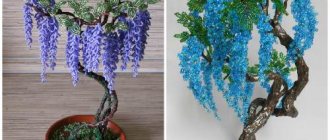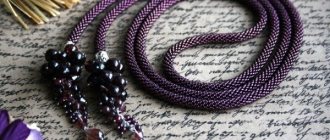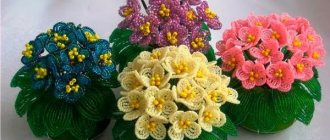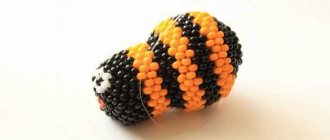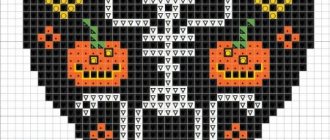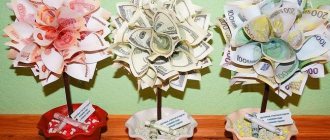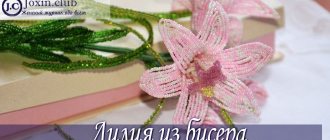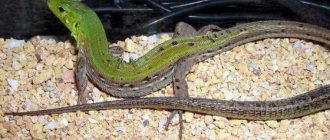Preparing for work
Looking at photos of beaded daffodils on the Internet, you probably noticed that the middle of the flower and the petals look different for everyone. In our case, there will be no complications; the flower will look very beautiful in three colors - yellow, green and red. But choose for yourself what you like.
You need to purchase working materials:
- yellow, green, red beads
- wire
- green floral ribbon
- wooden sticks (toothpicks)
- gypsum
- pebbles
- pot
- scissors
The process will take place in this order:
- Core (yellow and red beads).
- Petals (yellow b.).
- Leaves (green b.).
Tools and materials Time: 2 hours • Difficulty: 3/10
- white transparent beads;
- green transparent beads;
- yellow transparent beads;
- for buds and flowers you need to take 0.4 mm steel wire, and for greenery it is better to take green wire, also yellow to create the middle.
Narcissus is an amazing spring flower. A sign that winter has finally receded and a warm and green spring is ahead. And gardeners love to use it to decorate parks and garden plots.
And some who do not have their own piece of land grow daffodils at home. So we suggest you make an ever-growing daffodil from beads so that it will always delight you with its spring and warm appearance.
For work, we recall the basics of French weaving; lessons on its implementation can be found on our website.
Step 1: weave the petals
So, using this technique we weave the petals of our flowers. For one flower you will need 6 petals. The base will include an axis with 7 beads, and there should be 6 pairs of arcs in total.
Our composition will also include several flowers of smaller diameter. We will make smaller petals for them. The number of beads on the axis remains the same, only the number of pairs of arcs is reduced to 5.
Step 2: making the core
Now you can start decorating the core of the flower. To do this, we make loops on yellow wire, stringing 40 beads for each loop. There should be 12 such loops in total. This is the heap you should get.
- They need to be aligned and compressed.
Then we stitch the fabric of the loops so that they are pressed tightly against each other. Approximately in the center of the workpiece.
And we connect it all into a tube. The final touch for decorating the core is to bend the upper edges of the petals, forming the inner part of the flower.
Step 3: create stamens
Our flower needs stamens. They are quite simple to make. These are the bumps, 5-6 beads high.
Step 4: making buds
And any bouquet cannot do without buds. We make them from large leaves with 6 pairs of arcs on the axis. Just wrap them in a spiral and you will get such a cute bud.
Step 5: weaving leaves
To decorate each bud you will need 3 more green leaves. We also make leaves using the French technique. There are 10 beads on the axis, and only 3 pairs of arcs.
Step 6: Making Yellow Leaves
For each flower stem we will make one yellow leaf. In total we have 7 flowers in the composition, which means there should be that many leaves.
Step 7: Weave Long Leaves
All that remains is to make the longest leaves. There will be 65 beads on the axis, and a total of 5 pairs of arcs. Since the leaf is long, we sew it in two places.
Now the most interesting stage begins - collecting the bouquet and flowers. We use thick wire as a stem, to which we attach flowers and buds. And to decorate the stem, take a floral ribbon.
That's it, the beaded daffodils are ready. If someone found our master class or weaving pattern complicated, don’t hesitate to ask your questions.
Christina All posts by the author (1123)
Source: https://pleteniebiserom.ru/2012/03/nartsissy-iz-bisera/
Core
The middle of the flower consists of pistils and stamens. Our core will look like two colors - red and yellow.
- We string ten yellow beads onto a wire 30 cm long.
- Having formed a loop, you need to twist the wire several times. And so continue to string the beads, fastening the loops together.
- We weave five loops from yellow bugles.
- With twenty red pieces we repeat the same procedure of stringing and weaving with twisting, but in larger quantities - 13 pieces.
Huichol daffodils. Master Class
In this master class we will learn how to weave a very rare (for Mexican flora) and at the same time such a native (for us) flower - narcissus. Only he will gossip in a typical Huichol manner.
The flower itself is small, 4.5 cm in diameter, weighs just over 4 g. It is suitable for use in earrings, hair decorations, as well as necklaces and bracelets. One flower takes about half an hour or more.
- The master class will be based on weaving earrings from yellow daffodils with an orange center.
- We will need the following materials:
- - Czech beads of four colors: yellow (pearl), two shades of orange (opaque) and instead of traditional black, let’s take dark gray matte (translucent) - so our daffodils will be more delicate, as well as transparent matte (12 pcs. in total);
- — monofilament, bead needles, scissors, round-nose pliers for working with accessories; thread for beads (titanium);
- - earrings for earrings; the smallest bead huggers (golden), hair ties (preferably green).
I am often asked to show the weaving process from the very beginning.
The first three rows are absolutely the same in all colors and even in butterflies. But so be it, I’ll show you from the very beginning. The daffodil consists of two parts woven with one thread: the main flower and the middle part, which is called the crown.
Main flower
1st row . Weaving goes in a circle. We collect 12 light orange beads. We close it in a ring. We tie a knot. We secure the end by passing in a circle several times through all the collected beads until the end itself is hidden.
2nd row . We collect 5 yellow beads. From the knot we pass the needle into every second bead. There should be a total of 6 loops of five beads each. At the end of the row we pass the light orange and two yellow first loops above it. The needle should come out of the 2nd bead on the loop.
Our first six loops are the future petals of the flower.
3rd row . On the yellow loops of the 2nd row, we again collect 5 yellow beads, skip the 3rd one and enter the fourth yellow bead on the loop from top to bottom. Next, between the petals we collect 1 dark gray one and pass the needle from bottom to top into the 2nd bead on the next yellow loop. We rotate the actions on all petals. At the end of the row, we pick up the last dark gray bead, go first to the 2nd yellow one on the loop of the bottom row, then two more yellow loops of this row above it.
4th row . On the petals we collect loops of 5 yellow beads. We pass from the 2nd to the 4th, skipping the 3rd bead. Between the petals we collect 1 yellow - 1 dark gray - 1 yellow bead, and pass the needle through the second one from bottom to top on the next petal. At the end of the row we pass the 2nd yellow on the loop of the bottom row and the first two in the loop of this row.
5th row . There are again 5 yellow beads on the petals. Between the petals we collect 3 yellow beads, go to the dark gray one in the middle, collect 3 more yellow ones and go as usual to the next petal. At the end of the row we pass three yellow beads.
6th row . On the petals there are loops of 5 yellow beads.
Next, 3 yellow beads and the needle passes into the 2nd one, again yellow, only on a loop of three beads. Between the petals we collect 1 dark gray one and again look for the 2nd yellow one on a loop of beads, we pass into it from the bottom up. Next, 3 yellow ones and we go to the next petal. At the end of the row, it is traditional to pass three yellow beads through the loops of the bottom and this row.
7th row.
Last. On the petals, where until now we collected 5 beads, we now collect 3 yellow ones. Next, we collect 3 more yellow ones, look for the loop of the bottom row of three beads and pass the needle from top to bottom through the 2nd, 3rd beads and the yellow one immediately behind them (it belongs to the loop of three beads of the 5th row), pass in the dark -gray in the middle between the petals.
We climb up the first three yellow beads from the dark gray one (this is the bead of the loop of the 5th row and the first two behind it on the loop of the 6th row). Everything is marked with dots in the photo.
At the end of the row, having collected the last dark gray and then 3 yellow ones, go through the yellow beads of the first loop of this row and go down the entire petal down the central beads, to the very middle of the flower.
Tie a control knot at the base and bring the needle through the nearest light orange bead. The main flower is ready.
Crown The crown will be located between the light orange beads of the very first row so that its loops coincide with the flower. 1st row . We cast on a row of light orange loops, 5 beads in each, in the same way as we did in the main flower, in the 2nd row. At the end of the row, go through three light orange ones (middle and first loop).
2nd row . On the loops we collect 1 light orange - 3 dark orange - 1 light orange, between we collect 1 light orange. The principle is the same as when weaving a flower. At the end of the row we pass the light orange of the 1st row, light orange and dark orange on the loop of this row.
3rd row . Will be the last. On the loops we collect 3 dark orange ones, and between them 1 dark orange one, and thus our crown will be almost a tube, like that of a living flower.
At the end of the row, go through all the necessary beads (taking into account their number) and take the thread to the center, where you secure it with a knot, then take the end of the thread further away from the knot and only then cut it. If you plan to make earrings, then fasten the thread in the center and bring the thread to one of the petals.
We got a real daffodil! Now it remains to decide what exactly you will do with it. If these are earrings, then weave a couple of these flowers, collect 6-8 transparent beads on the petal and make a small loop for the earring. Pass through the beads in a circle 3-4 times to make it stronger.
Now hook the hooks.
If you plan to make hair elastic bands, then you need to close the center with a bead hugger or a bead of a suitable color and size, then sew it to the base elastic band with threads (not monofilament). Even if the thread breaks over time, the flower will remain intact.
For a bracelet or necklace with daffodils, you do not need to cut the working thread after finishing weaving. If the end allows, they can sew a flower. But after each stage, it’s better to tie a knot just in case - this way the flower will be much stronger.
By attaching it to the stem, you can make a three-dimensional flower. Weave several pieces and place them in a vase as a holiday table decoration. With a shorter stem, you can make a brooch and decorate your wardrobe. There can be many ideas, let your imagination tell you!
Good luck!
PS You can talk for hours about other techniques and ways of weaving daffodils, but Huichol daffodils are simple and spectacular, and therefore THE BEST!
Source: https://biserlen.com/huichol-nartsissy-master-klass/
Petals
They are made using French weaving. To study this technique in detail, you can watch the video here. Now let's look at the manufacturing diagram.
It's simple!
- You need to take a 50 cm wire and create a loop, string approximately 13 beads along the edges on one side, and 8 on the other.
- Next, we form arcs with beads and scroll them, as shown in the diagram.
- The arcs are formed parallel to each other and approximately 5-6 arcs are performed in a circle.
You need to make 6 pieces of petals.
Beaded narcissus
Author of the competition work: Yulia Galimova
Spring has already arrived and the first flowers will soon begin to appear. I want to share a master class of one of these spring flowers with you. And this flower is a narcissus.
Materials https://handmademart.net:
- Chinese white beads - Chinese yellow beads - Chinese orange beads - Chinese green beads - white wire No. 0.3 - green wire No. 0.3 - thick wire for the barrel - green floss threads
Flower: on a 55cm long wire. let's make a loop. (Fig. 1) One end of the wire is approximately 4-5, the other - 45. On the short end, this will be the axis of the petal, we collect 8 beads. (Fig. 2) We collect beads onto the long end of the wire and screw it one turn to the axis in this way: the wire from the arc lies on top of the axial one, then goes under it and after a turn returns on top of the axial one. (Fig. 3,4) At the same time, keep the axis straight. We collect beads again and screw another arc parallel to the made arc. (Fig. 4,5) Please note that after twisting the wire goes down parallel to the previously made arcs. For the flower we need to make 6 petals with an axis of 8 beads and five arcs.
Now let's start making the middle of the flower. We string it on a 50cm long wire. 25 beads (8 yellow, 9 orange and again 8 yellow) (Fig. 13). Make a loop and flatten it a little. (Fig. 14) We string the beads again and make a new loop. (Fig.15,16)
We will need to make 9 such loops. (Fig. 17) Next you will need to connect our loops. (Fig. 18) Now we connect the wires into a ring, (Fig. 19, 20) we twist the wires that were at the base, and we also twist and cut off those that connected the loops. (Fig. 21) Next, we compress the base to get a kind of bell. (Fig.22)
Leaves: take a wire 90-100cm. and make a small jam so that the beads do not roll off the wire. (Fig. 23) Next, we put 34-35 cm on the wire. green beads and make a loop. (Fig.24,25)
Now, we collect beads again, but 1-2 cm more than the previous value and make another loop around the loop. (Fig. 26, 27) To prevent the leaf from falling apart, we connect the wires with beads on the top and bottom of our leaf, in the same way as we connected the middle of the flower. You only need 2 of these leaves. (Fig. 27, 28)
And finally, we begin to collect our flower. First, take 3 white petals and connect them with wire. (Fig. 29, 30) Between them we add the middle (Fig. 31) and one by one we add between the petals, other petals (Fig. 32, 33)
Now we wrap our flower with floss threads to the trunk, i.e. to thick wire. (Fig. 34, 35) when about 3-4 cm remains until the end of the stem, add leaves. (Fig. 36) To prevent the thread from unraveling at the end, secure it with wire or a small piece of tape.
All that remains is to slightly bend the wire near the flower (Fig. 38) and the daffodil is ready.
760
Tags: Narcissus
Yellow flowers
Many claim that the yellow color of the flower symbolizes and portends separation, but you and I know that this is not so. It is enough to remember how the daffodil blooms, how much joy it brings with its beauty, and its yellow bud is like a sun that sways on a thin leg. How much goodness and charm these flowers carry. In this lesson we will tell you in detail how to make a daffodil with your own hands.
For this master class we will need:
- beads (yellow, green and white);
- wire (it is advisable to choose a material with a diameter of 0.3 cm);
- wire cutters (to cut the wire at the right time).
All this can be bought at a store that specializes in handicrafts. Once you have prepared everything you need, you can get to work.
We will start with the petals; to do this, thread 14 white beads into the wire and make an arc. Repeat this technique until you have nine arcs. This is for one petal. And for a full-fledged flower, you need to make five petals, therefore, you will get forty-five arcs.
When your petals are ready, you can move on to the core. Measure 30 cm and use wire cutters to cut the desired length from the wire. String 16 beads on it and bend it in half. You should now have a loop. Take a similar piece of wire and thread it through the six beads that come from the loop. You should now have two ends of wire coming out of the beads.
Place ten beads on the first piece of outgoing wire and twist them into a loop. Thus, continue weaving until you get 15 loops from the twists. Turn the entire product one side down and thread another piece of wire through the other side.
String only one bead on it and thread it through the six beads from the first loop, twist it. You should end up with a set of closed loops. Thread three green beads into the new wire and twist them from the bottom. All our parts are ready, all that remains is to assemble them into a single flower. Using a set of yellow loops, loop a long wire with green beads in a circle. You've got the core. Now you need to attach the petals.
The first three are attached first, and then the remaining two are carefully added. Twist all the pieces of wire together.
Note! Try to do all actions with very tight fastening so that our product does not fall apart.
Our lovely decoration is ready. You can create a beautiful bouquet of daffodils. To do this, do the entire master class as many times as you want to see flowers in your bouquet. When finished, you can beautifully arrange them in a decorative small vase, and your sunny mood will not leave you.

